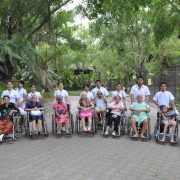A stroke occurs when a blood vessel that carries oxygen and nutrients to the brain is either blocked by a clot (ischemic strokes) or bursts (hemorrhagic strokes). When that happens, part of the brain cannot get the blood (and oxygen) it needs, so it starts to die.
The brain is an extremely complex organ that controls various body functions. If a stroke occurs and blood flow can not reach the region that controls a particular body function, that part of the body won´t work as it should.
The effects of a stroke will depend on the location in the brain and the severity of the stroke. If the location is toward the back of the brain it will likely affect the vision.
Why do some stroke victims develop hemi-paralysis?
Since the left side of the brain controls the right side of the body a stroke on the left side could produce paralysis on the right side of the body. A stroke on the right side of the brain would cause just the opposite (possible paralysis on the left side). A stroke could also affect language, behavior and memory.
What is the goal of rehabilitation?
Rehabilitation is a critical part of recovery for many stroke survivors. The effects of stroke may mean that you must change, relearn or redefine how you live. Stroke rehabilitation helps you return to independent living.
Rehabilitation doesn´t reverse the effects of a stroke. Its goals are to build your strength, capability and confidence so you can continue your daily activities despite the effects of your stroke.
So what steps can you take to help prevent a stroke?
– Control your blood pressure : Have your blood pressure checked often, and, if needed, take measures to lower it. Lowering high blood pressure reduces the risk for both stroke and heart disease.
– Stop smoking : Cigarette smoking is linked to increased risk for a stroke. Research indicates that the risk of stroke for people who have quit smoking for 2-5 years is lower than people who still smoke.
– Exercise regularly : Moderate exercise makes the heart stronger and improves circulation. It also helps control weight and lower the risk of both stroke and heart disease.
– Eat a well-balanced diet : Eat plenty of fresh vegetables and fruits and avoid saturated and hydrogenated fats. Eat fish regularly because it is an excellent source of omega-3 fatty acids. These acids prevent the internal blood clots, which trigger stroke.
– If you are diabetic, control your diabetes : If left untreated, diabetes can damage the blood vessels throughout the body and lead to atherosclerosis.



















